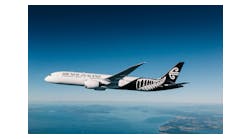Singapore Airlines is missing the party in its own home. Tourist spending in the city jumped by half since 2008, aided by two casinos and a 23 percent rise in passenger traffic through Changi Airport.
That growth has not been reflected in the carrier's passenger numbers, which are down by 2.2 million in the period.
The 12 percent drop is the largest of the 12 biggest publicly traded full-service airlines in the Asia Pacific.
Persian Gulf rivals are vying for premium passengers and low-cost operators are poaching budget travellers.
Singapore Air's slide contrasts with Cathay Pacific Airways, whose passenger numbers have risen 11 percent since 2008 because its Hong Kong base and a tie-up with Air China help it sell tickets in the world's most populous nation.
Singapore Air, overtaken by Air China in 2009 as the biggest airline by market value, will probably report a sixth straight decline in quarterly profit when it announces fiscal full-year earnings next week.
"The fact is that they're hurting," said Peter Harbison, executive chairman of CAPA Centre for Aviation, a Sydney-based company that advises airlines in the Asia Pacific.
"There's good cause for a fundamental review of Singapore's strategy."
Adversity is an unfamiliar experience for Singapore Air.
In an industry that has suffered almost 200 bankruptcies since 1979 in the U.S. alone, it can boast of having never made a full-year loss since it first sold shares to the public in 1985.
Like the iconic, demurely smiling "Singapore Girl" stewardess who adorns the carrier's marketing material, its performance harks back to an age when aviation was more glamorous - and even profitable.
"The economic downturn slowed some of our growth plans but we take a long-term approach," said Nicholas Ionides, a Singapore-based spokesman for the airline. "We invest in both good and bad times."
The carrier, controlled by Singapore state-investment company Temasek Holdings, may report a profit of 108 million Singapore dollars for the quarter ended March 31.
The analysts' forecasts suggest a net margin this year of 3.25 per cent. In the airline's first decade as a public company its average net margin was 16 per cent, sliding to 12 per cent in the following 10 years and 5.8 per cent in the past three years.
The price of jet fuel in Singapore has risen 38 percent since April 26, 2010, to $132.75 a barrel. Fuel now accounts for 40 percent of Singapore Air's costs, compared to an average of 27 percent since 2004.
The share price of the carrier, which also owns regional airline SilkAir, has tumbled 25 percent in the past year. Cathay Pacific has dropped 33 percent in the same period while AirAsia, the region's biggest discount carrier, jumped 23 percent.
Singapore Air faces greater competition on Europe-Asia routes as Emirates Airline and Qatar Airways leverage more convenient hubs and win premium passengers with improved service standards.
Regional and economy travellers are being targeted by low-fare airlines such as AirAsia and Qantas Airways' Jetstar.
"They're being squeezed at both ends of the plane," said Andrew Orchard, an analyst with Royal Bank of Scotland Group in Hong Kong who rates the stock a sell. "They have less growth now and a lot more competition."
Qatar was last year named the world's best airline by rating group Skytrax, an award that Singapore Air received in three years out of five until 2008, and has not won since.
Thai Airways International and Malaysian Airline System will also both add Airbus A380s this year, rivalling the carrier's flagship plane.
"Clearly the competition in some areas has got a lot better," Skytrax London-based spokesman Peter Miller said by e- mail, citing Qatar and Seoul-based Asiana Airlines. "We are seeing a more level playing field in product standards as many carriers seek to match Singapore."
The change has been noted by Singapore Air's regular fliers.
"They have this arrogant attitude that they're the best so people will continue to use them no matter what," said Mark Roberts, 48, a mining metallurgist from Melbourne who flies business class to Asia and Europe about 15 times a year.
Having flown exclusively with Singapore Air since 1998, in recent years he has increasingly chosen Thai Air and Emirates. "I felt like I was being taken for a fool by changes in Singapore Air's loyalty programme and the last-minute swapping of older aircraft on premium-priced routes.
"It' almost a lucky dip whether I get the product I paid for," he said.
The Boeing 747s that occasionally flew the Melbourne-Singapore route were retired from the fleet earlier this month, Singapore Air's Ionides said.
At Changi Airport, Emirates and Qatar alone operate 74 flights a week.
Low-cost carriers including Tiger Airways, part-owned by Singapore Air, have boosted their share of passengers to 26 per cent last year, from 5.6 percent in 2005, helped by the opening of a budget terminal.
Singapore Air now accounts for about a third of Changi's passengers, from more than half in 2008.
The decline reflects the government's move to boost tourism and limit dependence on manufacturing.
Visitor spending since 2008 has risen to S$22.2 billion, and the two casino resorts alone have increased sales from $6.6 million to $2.5 billion.
"If more airlines fly into Changi that makes Singapore more international," said Khee Giap Tan, an economist who has consulted on trade, tourism and economic policy for Singapore's government and is an associate professor with the Lee Kuan Yew School of Public Policy at the National University of Singapore. "We need more airlines."
Singapore Air's management is moving to increase their presence in the low-cost market. The carrier already owns 33 percent of Tiger Air and it's setting up a long-haul operator called Scoot. That new unit will start budget flights to Tianjin in China, Bangkok, Sydney, and Australia's Gold Coast this year.
That may be timely as the business travel market, long the backbone of Singapore Air's profitability, is trading down. First and business class growth peaked in May 2010 and has been lagging behind the overall market since October.
Rohit Deshpande, a professor of marketing at Harvard Business School who has studied the airline, cautioned against writing off a carrier that survived the 1997 Asian financial crisis, the September 11, 2001 terrorist attacks and the 2002-2003 SARS epidemic.
"I'm extremely bullish not only about their business model but about how smart they are in difficult times," he said.
On Singapore Air's main routes the focus is on contraction, rather than expansion. The carrier has cut flights since 2008 to cope with the more competitive market, and is offering pilots unpaid leave to seek work with other carriers.
Available seat kilometres - the standard measure of capacity in the airline industry - have fallen by 5.1 pecent since 2008 to 108 billion kilometres. The number of seats occupied by paying passengers has dropped even further, sinking 7.3 percent over the period.
"The world has changed for them," says CAPA's Harbison. "The days of being able to rely on the Singapore Girl to pull people in are gone."
Copyright 2012 Nation Multimedia GroupAll Rights Reserved





